Want to see penguins in the wild? Well South America is home to the Humboldt, Magellanic, Rockhopper, Gentoo, King and Galapagos varieties - learn where to see each with our short guide.
Penguins are some of the most charming and photogenic creatures on earth, however recent BBC wildlife documentaries have also shown us that wild penguins are also some of the toughest and most devoted, enduring tough conditions and long perilous journeys just to be able to feed their young and survive some often harsh conditions. Seeing them up close is guaranteed to put a smile on the face of any traveller and provide some of the warmest memories of your trip. So read on to find out some of the best places to see penguins in South America, where they come in a number of varieties and live in some very different habitats
Falkland Islands
8,000 miles from the shores of the UK is the small archipelago of the Falkland Islands, a British overseas territory where sheep roam rolling green hills and traditional inns are frequented by the locals. It sounds very familiar right? Well the Falklands are also home to various species of penguins, so large in number that they outnumber their human counterparts 250 to 1.
An island-hopping cruise through the archipelago allows you to get up-close to the inhabitants, including not just Magellanic, Rockhopper and Gentoo penguins, but also sea lions, elephant seals, hundreds of bird varieties and even the occasional killer whales. Volunteer Point, a headland on East Falkland, is also home to a large colony of majestic King penguins.
The Falkland Islands can be combined with tours in Patagonia or alternatively as part of a three week Antarctica cruise, for the chance to experience the extraordinary landscapes of the peninsula (and see even more penguins!).
 Gentoo, rockhopper, magellanic and king penguins in the Falklands
Gentoo, rockhopper, magellanic and king penguins in the Falklands
Galapagos Islands
The Galapagos Penguin is one of hundreds of fascinating endemic Galapagos animals that have evolved and adapted to live in the unique environment of the archipelago. They are in fact the only penguin to live either on or north of the equator or indeed in tropical conditions. They are thought to number less than 2,000 and so are listed as endangered by the WWF, partly due to climate change and the devastating effects of the El Niño phenomenon.
You can see penguins in many parts of the archipelago, particularly on the eastern coast of Santiago and the western side of its largest island, Isabela. They are often seen on the lava rocks of the shore, but can also be encountered when snorkelling nearby, this is because taking to the water is their principal way of cooling off, given that they have no sweat glands.

Chiloé Archipelago - Chile
When visiting the Chilean Lake District you will have will the chance to take a memorable day trip into the Chiloé archipelago to visit the fascinating island, famed for its traditional fishing communities, UNESCO churches and large colonial fortress - the last Spanish bastion in Chile. The journey itself though is full of intrigue, with the history and local myths of the island brought to life by the expert guide.
One of the highlights of the day is the visit to the the small cove of Puñihuil, where we find Humboldt and Magellan penguins breeding together on three small islands. Following a walk on the white sand beaches, a zodiac boat ride takes you up closer for a more intimate encounter and you may also spot other local wildlife, including sea lions, pelicans and cormorants. The best time to visit is generally between November and March.
Tierra del Fuego, Patagonia - Chile & Argentina
An expedition cruise through the fabled Tierra del Fuego archipelago is a wonderful way to experience the remote beauty and extraordinary wilderness of this region. En-route to the legendary Cape Horn - the meeting point of the Atlantic and Pacific oceans, you will visit pristine Patagonian forests, sail through the dramatic Glacier Alley and even discover a small archaeological site, thought to date back some 10,000 years. There will also, of course, be a close encounter with a remote Magellanic penguin colony at Magdalena Island.
Alternatively, those visiting Ushuaia in Argentina, but not departing on a multi-day cruise, can see Magellanic penguins up close at Martillo Island, on a day trip from the world's southernmost city. As well as enjoying panoramic vistas of the landscape here, there will be the opportunity to observe seals, albatrosses and various other sea birds. Alternatively, from the base of Punta Arenas in Chile you can reach the aforementioned Magdalena Island on a day trip.
Discover Tierra del Fuego in Argentina and Chile.
 Magellanic Penguins, Isla Magdalena in Tierra del Fuego (photo by Vera & Jean-Christophe)
Magellanic Penguins, Isla Magdalena in Tierra del Fuego (photo by Vera & Jean-Christophe)
Punta Tombo & Peninsula Valdes, Patagonia - Argentina
Further north, on the rocky eastern coast of Argentina, is the Punta Tombo National Reserve, in the heart of Welsh Patagonia. Located around 80 miles from the town of Trelew, Punta Tombo is home to what is considered to be the largest and most important breeding colony of Magellanic Penguins on the continent. From September each year thousands of birds begin to arrive, migrating south to nest and staying until mid-March.
As well as the mass of penguins, it is also possible to see a variety of sea birds, including gulls, skuas and cormorants, as well as roaming guanacos. Before returning to Trelew you can also visit the typical Welsh settlement of Gaiman, in the Chubut River Valley, where you can enjoy a traditional Welsh afternoon tea.
Punta Tombo can easily be combined with a visit to the nearby Peninsula Valdes, where you can observe Magellanic penguins, sea lions, elephant seals, Southern Right whales and orcas at close quarters.
Paracas & Ballestas Islands - Peru
A short flight down the Peruvian coast from the capital Lima is the Paracas National Reserve, an area of protected land which extends out into the Pacific Ocean. Boat trips depart from the village of El Chaco and carry visitors out into the waters of the reserve and on towards Ballestas Islands. Among the residents competing for space here we find a great abundance of pelicans, sea lions, fur seals, a variety of migratory birds and, naturally, charming Humboldt penguins. Whilst you cannot actually go on to Ballestas Islands without permits, the boats provide excellent vantage points from which to observe and photograph the wildlife.
Paracas can combine perfectly with a flight over the mysterious and ancient Nazca Lines, a glimpse of which can be seen from the boat. It also provides a viable alternative to those who do not have the time or budget to visit the Galapagos Islands, but who would like to get closer to the continent's sea birds and marine life whilst visiting Peru.
Visit Paracas & the Ballestas Islands
 Humboldt Penguins on Ballestas Island (photo by Frank_am_Main)
Humboldt Penguins on Ballestas Island (photo by Frank_am_Main)
Choose your perfect holiday
Find inspiration from our selection of itinerary suggestions, a great starting point for your next trip
View More Tours
Stay in touch
Infuse your travels, with inspiration from our monthly newsletter.
READY - 20 April 2024
LANDMARK TOURS: Multi-Country & Cross Continent. New Cosmopolitan Tour: Buenos Aires, Iguazu, Rio
CHINA & INDIA: Local Life, People & Unique Cultures
GUIDES by Veloso Tours, are the best Local Hosts
PRIVATE VILLAS: Quality Time in exclusive settings
TRAVEL INSURANCE with extensive COVID-19 cover






